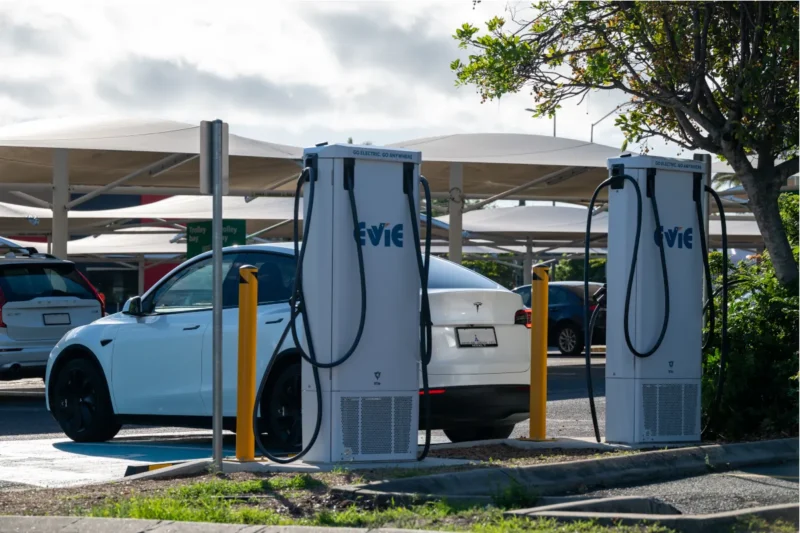Access to public charging in Australia should not be a barrier for most Australians to choose to own and drive an EV. I’m sure many readers are already fuming at this statement and I am certainly not out to excuse the occasions when you pull up to a broken charger, have to queue or meet some other frustration.
However most of the time, for most people; the installed base of public charging available is sufficient to Australian drivers to meet demand.
I’m also not arguing to slow down the investment in charging infrastructure, far from it, if we want to decarbonise our transport system then equitable access to the critical infrastructure is essential and construction needs to stay ahead of growing demand.
Busting the myth that the lack public charging is an impediment to most people owning and driving an EV is an urgent priority for our industry. There are some key stats that make Australia uniquely well positioned for a rapid uptake of EVs.
Firstly, Australians don’t actually drive very much. Sure, we live in huge and sprawling cities and like to dream about the massive road trips we’d like to do, but the numbers don’t actually bear this out.
Australians drive on average 13,800km a year, compared to 18,000km a year in Western Europe and 20,200km a year in the United States. When we go long distances, we fly. In 2024 Melbourne to Sydney was the 5th busiest flight route in the world.
The other factor in our favour is how we live – 70% of Australians live in single family homes and another 13% in townhouses; and whilst not all of these dwellings will have garages and driveways the vast majority of them will.
So if the average Australian drives 38km a day and returns to a home with a driveway or a garage (and often has solar PV as well), why are EVs not selling? Edgecases and outliers dominate the narrative, no one likes to think of themselves or their needs as average and there is no denying that there are some things that are harder to do with an EV.
If you have an ICE vehicle in the driveway, you can pull out of the driveway, and without much of a thought get to almost anywhere in Australia the roads go. If you’ve driven an ICE car, have you ever asked it’s GPS to plot a route and had it lay out which petrol stations to stop at?
My own experience working for a CPO (charge point operator) and in conversations with other CPOs shows that public charging behaviour groups people into two broad categories; those that charge daily and weekly – people who drive for a living and apartment dwellers that have little alternative to a weekly public fast charge, and those that charge rarely, often around Summer or Easter, the big Australian driving holidays. There’s also a massive cohort of people you don’t see in the public charging records, who just don’t charge in public because they don’t need to.
People tend not to anchor to the mundane daily utility of their cars but the edge cases where a few times a year they take a trip. The curse of individual vehicle ownership, the reason why it is so difficult to get people to transition is that its pretty easy to meet 100% of you needs, relatively economically with one vehicle, even if it pretty unsuitable for urban driving.
Why else would my neighbour head out every day in a Landcruiser decked out with recovery boards and shovel? Melbourne potholes are bad, but not that bad.
It’s only reasonable that someone considering replacing their ICE vehicle, that can meet 100% of their needs, transition to a mobility solution that also meets 100% of their needs; but it doesn’t have to delivered in the same form. We can get creative with how we meet driver needs.
How about we underwrite people’s edge case trips by including a car rental or car share voucher for when they need to travel out of their comfort zone, need a different vehicle or just want to try something else? Perhaps people will use it, or perhaps they will learn they can make it to the beach and back with confidence in their EV.
We also need to solve for outliers – the growing minority who live in appartments and the inner cities without access to home charging and for the high km drivers for whom daily access to public charging is a priority need. For the inner city dweller, I would ask the question, ’How much does your mobility actually depend on a car’.
I was liberated from car ownership way back in 2007 and a combination of bikes, public transit, ride share, car share and car hire has met my needs ever since. Even as the other modes have electrified, It’s a frustration that those car share hires are rarely electric and there is definitely a problem to be solved there.
Of course that doesn’t work for everyone who lives in the inner city and relies on a car to meet their daily or weekly mobility needs; many inner-city and apartment dwellers do make EVs work, whilst provision in apartment buildings is still poor and retrofitting can be an expensive challenge, many drivers make it work by fitting a public charge into their weekly routine.
The problem here is one of equity, it’s a lot cheaper to charge at home, so apartment dwellers are penalised by their reliance on public charging.
Of course, none of this means investment in charging should stop but we need to make it more effective, more sustainable and deliver a return for investors whilst still delivering ubiquitous, accessible and equitable critical infrastructure. Many complaints centre around the paucity of the provision of chargers in regional centres, often a single 50kW charging head.
These are crucial to giving confidence to prospective EV drivers, often in an outsized way with some segments, but they are currently a terrible investment for those that are building them. For many of those regional sites, and even many suburban ones, revenue is not even close to covering operating costs.
At the other end of the spectrum, the best locations for charging the locations that will generate a return by serving the most drivers are also some of the hardest to build in. If there is a problem to be solved it is ensuring that CPOs can deliver the growth in charging capacity that we definitely will need by delivering the return on investment that makes it easy for them to raise money.
Getting people into EVs is about giving people confidence and engaging them in a conversation about the transition. The best thing about an EV is not having to think about fuelling beyond plugging in at home.
The worst thing about an EV is heading out into the unknown, unsure if you can make it back. Solving this is crucial to solving Australia’s EV uptake problem. It won’t be solved simply by building more charging but by changing how people think about how they access mobility.

Ed Lynch-Bell is Principal at Second Mouse, dedicated to building more sustainable energy tech and mobility products, services and businesses. Ed is also a co-host of the Melbourne and Sydney EV Meet-ups, bringing the e-mobility industry together.

